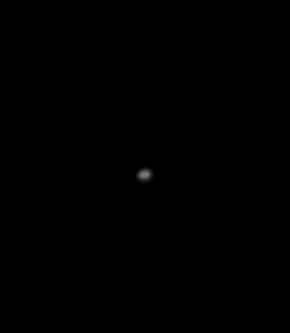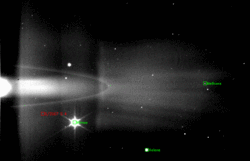Anthe /ˈænθiː/ is a very small natural satelliteofSaturn lying between the orbits of Mimas and Enceladus. It is also known as Saturn XLIX; its provisional designation was S/2007 S 4. It is named after one of the Alkyonides; the name means flowery. It is the sixtieth confirmed moon of Saturn.[5]

Anthe is the ellipsoid in the center
| |
| Discovery | |
|---|---|
| Discovered by | Cassini Imaging Team [1] |
| Discovery date | May 30, 2007 |
| Designations | |
Designation | Saturn XLIX |
| Pronunciation | /ˈænθiː/[a] |
Named after | Άνθη Anthē |
| Adjectives | Anthean /ænˈθiːən/ |
| Orbital characteristics [2] | |
| 197,700 km | |
| Eccentricity | 0.0011 |
| 1.05089 d | |
Average orbital speed | 13.824 km/s |
| Inclination | 0.1° to Saturn's equator |
| Satellite of | Saturn |
| Group | Alkyonides |
| Physical characteristics | |
| Dimensions | 1.8 km [3] |
| 0.9 km | |
| Circumference | ≈ 5.7 km |
| 10.18 km2 | |
| Volume | 3 km3 |
| Mass | 1.5×1012kg[4] |
Mean density | 0.5 g/cm3 |
| 0.00012 m/s2 (0.12 mm/s2) | |
| ≈ 0.56 m/s (≈ 2 km/h) | |
| assumed synchronous | |
The designation S/2007 S 4 was also accidentally and incorrectly used for a different Saturnian satellite discovered later. The published discovery was retracted a few hours later and republished the next day under the correct name of S/2007 S 5.
It was discovered by the Cassini Imaging Team[1] in images taken on 30 May 2007.[2] Once the discovery was made, a search of older Cassini images revealed it in observations from as far back as June 2004. It was first announced on 18 July 2007.[2]

Anthe is visibly affected by a perturbing 10:11 mean-longitude resonance with the much larger Mimas. This causes its osculating orbital elements to vary with an amplitude of about 20 km in semi-major axis on a timescale of about 2 Earth years. The close proximity to the orbits of Pallene and Methone suggests that these moons may form a dynamical family.
Material blasted off Anthe by micrometeoroid impacts is thought to be the source of the Anthe Ring Arc, a faint partial ring about Saturn co-orbital with the moon first detected in June 2007.[6][7]
Media related to Anthe at Wikimedia Commons